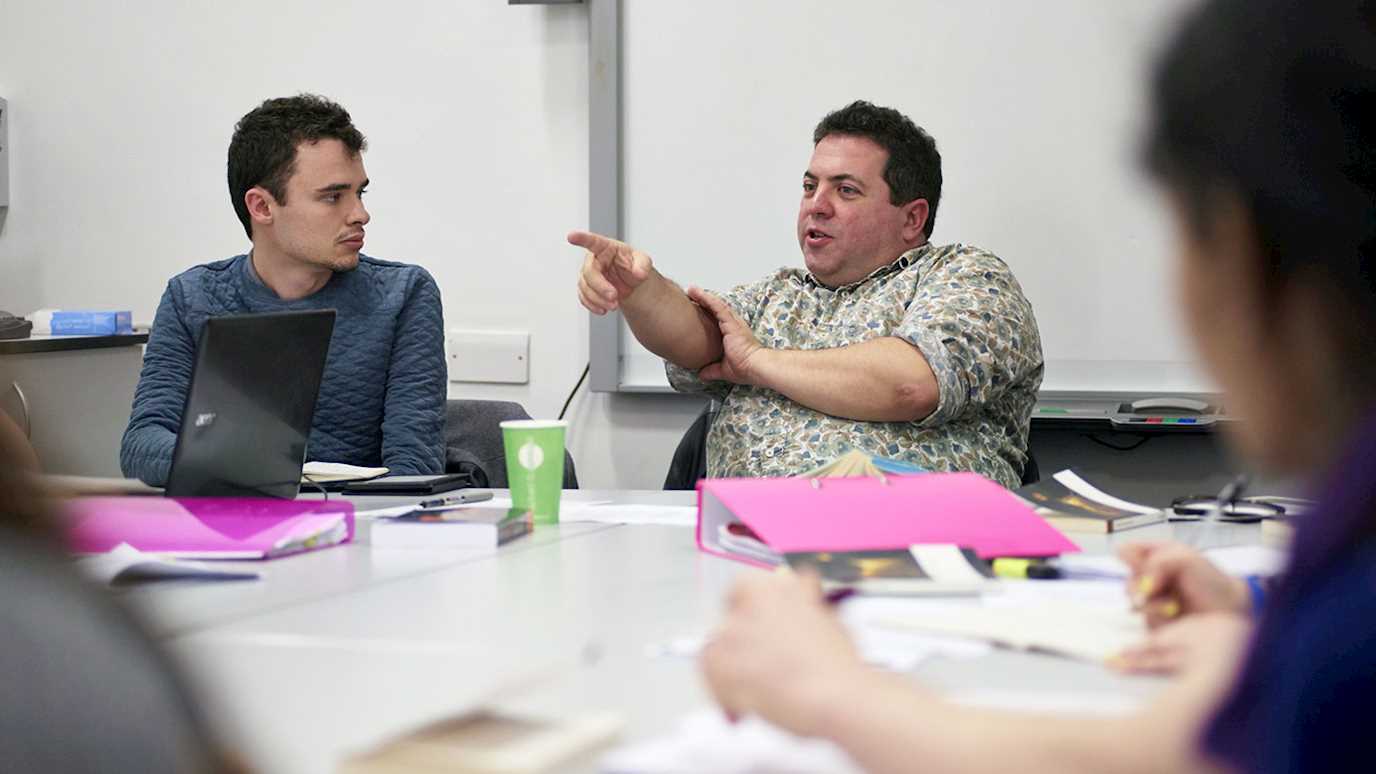Dr Harry Newman on William Shakespeare's The Tempest
Key points
1. Address issues of genre
- Great play for tackling issue of genre: question what kind of play is this? It seems simple but is actually complex.
- Important to show students that many different ways of categorising this play:
- Obvious answer: ‘Comedy’, often funny and seems to have happy ending (how categorised in First Folio of 1623, first collection of Shakespeare plays in which The Tempest was first published)
- But also potentially a ‘tragi-comedy’, i.e. a comedy suffused with tragic elements.
- ‘Late play’ (last solo-authored play; Shakespeare’s ‘swansong’, farewell to theatre)
- Romance’ (from C19; along with other late plays like Cymbeline, The Winter’s Tale, with which it shares many characteristics, including perceived drive from tragic circumstances to reconciliation, rebirth and regeneration)
- Of course, it would be a mistake to let students think that just one of these terms is appropriate or correct.
- Early moderns had a more fluid and inclusive understanding of dramatic genre than we do, and were much more open to plays that allow the comic and the tragic to bleed into one another. Indeed, when The Tempest was first performed in 1611, tragi-comedy was in vogue as a genre, especially because of a series of collaborations between two playwrights called Beaumont and Fletcher.
- The purpose of asking students about genre is not just to get them thinking about how to categorise this play, but also make them interrogate what it means to categorize a play. Assigning terms of genre to plays is an interpretive decision suggestive of how you view play. When students call a play a ‘comedy’, ‘tragicomedy’, ‘romance’ or ‘late play’, they should consider what they are doing to that play as a critic. Terms of genre often say a lot about those who use them as well as about the plays they’re applied to.
- For instance, earlier I said The Tempest was comedy largely because it seems to have happy ending, but we might question the comic form of the play by asking how happy the ending really is.
- E.g. Antonio’s silence is particularly problematic: when Prospero forgives his usurping brother, and tells him he ‘requires /My dukedom of thee, which perforce I know / Thou must restore’, it is not Antonio but the penitent King Alonso who responds: ‘If thou beest Prospero, / Give us particulars of thy preservation’ (5.1.132-35). Actors and directors may occasionally choose to have the brothers embrace in silence, but it certainly doesn’t have to be played that way, and the text denies us the forgiveness and satisfaction that the dramatic form of comedies and especially romances promises. It’s worth asking your students why they think this is, and the extent to which moments like these problematize the straightforward categorization of the play as a ‘comedy’.
2. Get political
- Antonio’s silence is politically as well as generically problematic: it is not a restoration of political harmony so much as a re-usurpation of power by deposed ruler. It’s worth thinking in particular about political ambiguity.
- The Tempest is a deeply political play which raises questions about different forms of authority, including that of Prospero.
- The Character list in the First Folio identifies ‘the rightful Duke of Milan’, but play itself gives us more reason to doubt Prospero’s legitimacy, competence and benevolence both as Duke of Milan, and as the ruler of the island.
- Prospero’s relationship with Caliban may be of particular interest to students, as from a certain perspective Prospero is coloniser who has enslaved the only inhabitant of the island. Indeed, many productions over last half century or so have had Caliban played by black actor, and emphasised the cruelty of the white Prospero.
- If you put stock in what Caliban has to say about Prospero’s authority on island, as many post-colonial critics have, we might even see Prospero as a kind of usurper himself: ‘This island’s mine by Sycorax, my mother, / Which thou tak’st from me’(1.2.332-33). From Caliban’s perspective, Prospero has done to him what Antonio did to Prospero in Milan.
- As for what we know of Antonio’s usurpation itself, we – like Miranda – get the story from Prospero, who is intentionally condemning his brother. But along the way Prospero does – perhaps unconsciously – suggest that he is partly responsible.
- It is well worth having close look with students at 1.2 (the long scene where Prospero explains to Miranda how they came to be on the island before we meet Ariel and then Caliban). Prospero’s anxiety about the fact that he – in his words – ‘Awaked an evil nature in my brother by ‘neglecting worldly ends’ while ‘rapt in secret studies’ (1.2.93, 89, 77), registers in not only his use of particular word choices and metaphors, but also the knotty syntax and highly irregular metre of his verse, with its extra syllables and its non-iambic stress patterns. His speeches are wonderful examples of how verse forms are often as important to characterisation as linguistic content.
3. Explore literary form, and especially shifts between verse and prose
- My experience is that students can have difficulty recognising the differences between verse and prose as literary forms. Getting students to read dialogue out-loud, and even getting them to tap or stamp out metrical patterns, is always good method of illustrating the differences between verse forms and between verse and prose.
- Beyond this, it’s important that students explore how shifts between these forms can achieve powerful dramatic effects.
- The Tempest is fantastic for illustrating some of these effects because – as in his late plays more generally – in this play Shakespeare highly experimental both with irregular, variable verse forms and with deploying prose in unexpected places.
- Students may have heard that aristocratic characters speak in iambic pentameter while lower class characters speak in prose, and you can show them this is not always true (just look at the opening scene, for instance), and that – depending on the context – shifts in literary form can alert us to number of other kinds of shifts, including reversals in character, the enhancing and slackening of dramatic tension, movement between comic and tragic modes, artificial and natural speech, formality and informality, public and private discourse, and so on. In short, Shakespeare shifts between literary forms to open up new linguistic spaces (verse and prose are different languages if you like), and students need to be taught how to recognise, read and interpret those linguistic spaces and those languages.
- Ask students to analyse individual examples as well as over-arching patterns.
- E.g. In 2.1 as survivors of shipwreck wander about the island, why is it that Antonio and Sebastian make fun of Gonzalo aside in prose while the adviser Gonzalo speaks in verse as he tries to comfort King Alonso? Their cynicism and subversion is apparent from their jokes, but to what extent is it also communicated by their sneering prose in contrast to Gonzalo’s ceremonial verse?
- Also, why is it that Caliban speaks in verse both to Prospero and to himself, and even – for the most part – to Trinculo and Stephano, the drunken butler and jester who would seem to be prosaic in nature as well as speech? While Caliban is seen by most of the other characters as a foul and deformed ‘monster’, should we recognise him as ‘a poetical being’, as the early C19 critic Schlegel called him?
4. Analyse Prospero’s epilogue
- Prospero’s epilogue is a particularly fruitful passage of verse to focus on in close reading exercises, but also one that can open up productive discussions about whole play.
- Students might explore how Prospero’s plea that the audience set him free with ‘the help of [their] good hands’ now that his ‘charms are all o’erthrown’ draws together the plays thematic interests in bondage and magic. But as a direct address to the audience that explicitly forces them to recognise their own role in the processes essential to the magic of theatre, the epilogue is a metatheatrical moment that frames a play which is highly self-reflexive, and obsessively returns to questions about the complex relationship between art and life. An obvious moment to compare is Prospero’s ‘these revels now are ended’ speech after he interrupts the masque in Act 4.
- As well as comparing the epilogue to other moment in play, you might want to explore links and contrasts with epilogues to other Shakespeare plays, especially those spoken by spoken by Puck in A Midsummer Night’s Dream and by Rosalind in As You Like It.
- All serve function of requesting applause and commendation from audience, but are also very effective in highlighting fractured identity of speaker between the character and the actor playing him or her. The Tempest’s epilogue is often said to be unique in Shakespeare because its speaker represents himself as an actor in a play (asking for applause that will allow him and his acting company to continue a successful trade), but the speaker also represents himself as a character in a play-world (asking to be able to continue his story beyond the borders of the text).
- As for how to get students to analyse the epilogue itself – there are a number of options:
- Verse form: it is important that the speech consists of 10 octosyllabic couplets, so you could have 10 students read out a couplet each, as a way of getting them invested in the speech as well as encouraging them to explore significance of speech’s verse form, which has been identified as incantatory or even moralising in nature.
- You could even get students to analyse a couplet each in groups before exploring connections between them as a class. This helps for thinking about them as powerful semantic units in themselves as well as building blocks for the speech as a whole.
- Watch the epilogue being performed by different actors in different productions, giving them the experience of a direct address to an audience, and inviting them to compare and contrast interpretive choices in performance.
- Good point to finish on: getting students to watch or even participate in performances of the play is a very effective way of helping them to recognise what this play is doing—among other things—generically, politically and formally, and experiencing performance is essential for understanding what is arguably the central concern of the play: performance itself, the power of the theatre and its relationship to life.
Quotations
From Stephen Orgel’s Oxford edition of The Tempest (1987)
- Antonio’s silence, especially ‘For you, most wicked sir…’ to ‘…of thy preservation’ (5.1.130-35)
- Caliban’s condemns Prospero for usurping rule of the island and mistreating him: ‘This island’s mine … rest o’th’ island’(1.2.331-44)
- Prospero tells Miranda about how Antonio usurped his dukedom: ‘My brother, and thy uncle…’ to ‘…With all prerogative’ (1.2.66-105)
- Antonio and Sebastian mock Gonzalo, e.g. ‘Beseech you…’ to ‘…most learnedly delivered’ (2.1.1-46)
- Caliban as a ‘poetical being’, unlike Trinculo and Stephano, e.g. ‘Art thou afeard…’ to ‘…music for nothing’ (3.2.131-43)
- Prospero’s epilogue, from ‘Now my charms…set me free’ (5.1.319-38)
- Prospero musing on relationship between life, art and theatre after interrupting masque, from ‘Our revels now are ended…rounded with a little sleep’ (4.1.148-58)
Further reading
Digests written by Aimee Le
Stephen Orgel, ‘Introduction’ ed. Stephen Orgel, The Tempest (Oxford: OUP, 1987) [long but has a number of subheadings which would help teachers to navigate their reading.]
The classification of The Tempest as a romance might draw it away from useful comparisons to both comedy and tragedy. Fundamentally, there is a great deal of inconclusiveness in the text, which has been mustered in support of differing arguments (representations of Prospero and Caliban as sympathetic or unsympathetic, for example). One interesting ambiguity is Miranda’s mother, only referenced once, and the absent Sycorax, mother of Caliban, who provides him with his ‘claim’ to the island. (These claims to power on the basis of either will or descent had direct relevance to James I’s possible—and multiple—claims to the throne.) In performances from the late 18th to the early 20th century, the harsher passages between Miranda and Prospero, which represent Miranda as less innocent (1.2), were cut, and her speech to Caliban beginning ‘Abhorrèd slave…’ reassigned to Prospero in editions of the text during this period as well. There is significant ambiguity in the nature of Prospero’s magic throughout the play: whether it is divine, scientific, diabolical or angelic—or indeed frivolous, since the study of it causes Prospero to abdicate his dukedom initially setting off the entire movement of the play. Caliban’s presence introduces the question of Prospero’s political control over others, as well as the question of sovereignty. Prospero’s fears for his daughter’s chastity and his attempt to produce reconciliation through marriage relate directly to the forms of political marriage practiced during the Jacobean era. ‘The underlying assumptions here… are implicit, too, for example, in Ralegh’s selection of the name Virginia for his new colony. The epithet acknowledges the extent to which virginity had become, in Elizabeth’s rein, a crucial attribute of royal power’ (49). The valuation of virginity also comes up in comic form in the evaluation of Dido and Aeneas; in the traditional myth, Dido remained chaste and faithful to her dead husband, however, Virgil introduces a storyline in which Aeneas seduces her.
From the Restoration to the beginning of the Victorian era, The Tempest produced was generally not Shakespeare’s original, but rather, the amended editions of Davenant and Dryden and the operatic production of Shadwell. It was largely known as a technical spectacle of music and effects. By the time performances of the original text became popular again, certain conventions had altered away from Davenant as well: Ariel was typically cast as female (having been cast as male in the 17th century), Caliban began to take on a more malign cast (having been portrayed in Davenant as essentially comic), and Prospero’s magic was potentially diabolical. The play was still known for its often excessive special effects. In the 20th century, productions began to emphasize the Jacobean origins of the play, which led to turns toward the ‘original’ aspects of Shakepeare’s play: Ariel became a male role again, leading to less sympathetic portrayals with unearthly emphasis, Prospero’s age (hitherto assumed to be advanced) was called into question, and the play’s ambiguities fully exploited. In this sense, the author suggests, the focus of modern productions of The Tempest has been increasingly textual—engaging with the text as it is rather than attempting to sculpt it into resolution.
Alexander, Catherine M. S., ed. The Cambridge Companion to Shakespeare’s Last Plays. Cambridge: Cambridge UP, 2009.
While they’re often referred to as Shakespeare’s ‘late’ plays, the editors of this volume have chosen to refer to ‘last’ plays, since ‘late’ carries with it themes of reconciliation, maturity and old age which have often been overemphasised in readings of these plays. A significant myth surrounding The Tempest is that of Prospero representing an autobiographical Shakespeare bidding farewell to the stage. In fact, The Tempest is not Shakespeare’s last play, considering his several subsequent collaborations with Fletcher. Shakespeare’s ‘late style’ is generally symbolized by ‘romances’ or ‘tragicomic romances’ such as The Tempest, which begin with possible tragedy, exile, etc., but however end in reconciliation. Furthermore, the writing is less direct, relying on “ellipsis, asyndeton, convoluted syntax, heavy dependence on parenthesis and repetition” (7), and less thorough characterisation. The King’s Men began to use a second playhouse, the Blackfriars, which possibly affected staging decisions (The Tempest was written in 1610-11). Most notably, Blackfriars was indoors and music was more readily available at the venue. The Tempest is one of Shakespeare’s most musical plays, and the music is used both directly and symbolically in the play (as in the masque). The theme of reconciliation in Jacobean romances was also one of King James I’s reign, given questions of governance and “national identity in the context of colonial expansion, overseas travel and the state’s relationship with foreign powers” (81). The King James Bible had been published only a few years before The Tempest, intended to replace the mutually exclusive Geneva Bible and Bishops Bible.
Texts that draw upon or read The Tempest : Browning, in the 19th century, used Caliban as an exemplar of colonized people and their ‘educability’; Percy MacKaye devised a popular masque for the 300-year anniversary of Shakespeare’s death, called Caliban by the Yellow Sands, addressing the problem of educating immigrants to America into Anglo-Saxon culture; Auden in The Sea and the Mirror and H.D. in By Avon River, as modernists, produced more fragmented works dealing with the limitations of art’s power (both texts were split into parts, indicating the modern conception of human nature as divided). After WWII, Prospero’s role as a possible ‘coloniser’ came in for more attention, particularly his relationships of bondage to Caliban (permanent slavery) and Ariel (indentured servitude). Aimé Césaire’s 1968 Une Tempête sees black actors putting on white masks to play the ‘white’ characters. Kamau Brathwaite also wrote through Caliban in Letter Sycorax. Others have sought a feminist reading of Miranda, such as Margarat Laurence’s 1974 The Diviners—or addressing both Miranda and Caliban in rewriting the tale entirely, as in Marina Warner’s Indigo and Gloria Naylor’s Mama Day. What nearly all of these 20th and 21st Century retellings have in common is that they decentre Prospero.
Howard, Jean. “Shakespeare and Genre.” A Companion to Shakespeare. Ed. David Scott Kastan. Oxford: Blackwell, 2000. 297‐310.
While in the first folio Shakespeare’s plays were divided into the three genres of history, comedy, and tragedy (without the additional categories added by later scholars of ‘problem plays’ and ‘romances’), these genres are always somewhat unstable and dependent on critical judgement. For example, Richard III in the past was listed as a tragedy; King Lear as a history; The Tempest as a comedy, and plays could be categorised multiply depending on their features. This generic categorisation was also very dependent on how Shakespeare’s dramas were standardized through being put into book form—they were not necessarily slotted into genres in performance, although audiences would anticipate genres through references and affiliations to other play, and certain venues or companies would set up generic expectations. For Philip Sidney, the problem of genre was also one of class identity: the improper combination of multiple genres could lead to the wrong kinds of people or ‘matters’ mixing on stage. However, this generic mixing could also be the result of multiple authors, common in the early modern period. Additional genres of the time such as ‘city plays’ were clearly dependent on historical developments which made urban space a fraught issue, and Shakespeare clearly drew on the generic tropes of his contemporaries (for example, Measure for Measure has been discussed as a ‘problem play’, but it shares many features with the ‘city plays’—although notably, Shakespeare does not go into much detail in depicting the middle classes, which his contemporaries did).
Palfrey, Simon. “What difference does prose make?” Doing Shakespeare. London: Arden, 2005. 106‐33.
In Shakespeare the standard medium is blank verse; however, his plays contain from 10 to 40 percent prose (The Tempest is about ¼ prose). When verse switches into prose in Shakespeare, it is usually for a notable reason, such as a comic shift or to indicate disorder (drunkenness, madness, emotion). Shakespeare’s prose draws upon both the rhetorical model (associated with Cicero) and the ‘consciousness-unfolding’ model (associated with Seneca and Montaigne). He also clearly uses characterisation and double-meaning in prose. However, he is less likely to be syntactically elliptical; because of its clearer grammar, Shakespeare’s prose is more directly and immediately comprehensible. This can also mean that it gives more room for the actors to control the pace and emphasis of their lines. The division between prose and verse, however, is not always stark: Shakespeare transitions verse techniques and grandiloquent topics into prose treatment and include ‘prosaic’ devices such as repetition in his verse, extending metre slightly beyond a line, splitting verse between two speakers, etc., and indeed, this is how Shakespeare achieves some of his most striking and powerful characterisation—for example, Othello’s break into prose (hitherto largely spoken by Iago in villainous asides) indicates the tumult of his emotions, and initiates a mixture of prose and verse from then on; Macbeth’s inability to finish the full pentameter of each line, or occasionally overrunning it, creates a sense of unease and untrustworthiness.
aughan, Alden T., and Virginia Mason Vaughan, eds. The Tempest: A Critical Reader. London: Bloomsbury, 2014. [Especially see chapter 8, Nathaniel Amos Rothschild, “‘volumes that / I prize’: Resources for Studying and TeachingThe Tempest”.]
politics [2] travel, geography, and colonialism [3] gender, sexuality, and marriage [4] music and masque and [5] magic and education.
The Tempest, because of its themes of political and social control, became very popular for critical readings in the 20th century. Helpful resources might address cosmic and social hierarchies of the time (the ‘great chain of being’ or ‘natural order’), as well as questions of Prospero’s magic in relation to its multiple roles: as political power and mastery, as science (the ‘great globe’ he references might refer to Copernican ideas of the firmament rather than, as is the typical reading, the earth), and as a pure artifice or spectacle. Marriage is a relevant historical theme as well as a textual one, given that The Tempest was performed in 1613 to celebrate the marriage of King James I’s daughter Elizabeth. In order to deepen a sense of historical context of the forms of discipline in the play, students might benefit from reading excerpts from early modern pedagogical treatises such as Richard Mulcaster’s Positions… for the training up of children or Montaigne’s ‘Of the Institution and Education of Children’, as well as writing that directly addresses women’s roles. Some audio performances of musical settings are also available.
Sources from which Shakespeare drew from directly include Ovid (Prospero gives a speech which is given by Medea in Ovid), Virgil’s Aeneid, Montaigne’s ‘Of the Caniballes.’ Less direct, but probable influences include Ben Jonson’s masques, particularly Hymenaei, Faust, Machiavelli, commedia dell’arte, and accounts of the New World, particularly the shipwreck of the Sea Venture.
Of the three major editions of Shakespeare’s collected works, the Riverside (1974) emphasises more traditional criticism of The Tempest, while the Complete Works (1980) and Norton (1996) editions draw on more contemporary responses. Among the multiple-play editions, the Norton is a bit more user-friendly and readable than the others. Of the single-play editions, the author recommends the Arden series edited by Virginia Mason Vaughan and Alden T. Vaughan for its thorough appendices. There are also the Oxford and New Cambridge editions. Christine Dymkowski’s heavily annotated Tempest is probably inappropriate for students but could be helpful to actors, directors, or performance scholars. The Norton Critical Tempest has a wealth of supporting material (perhaps too much for introductory students). Smaller teaching editions are also available, such as the Signet Classic edition and the Pelican edition, but the author recommends the New Folger Library edition. Online resources can be helpful, providing audio-visual material as well as interactive annotations and digital comparisons of folios and editions. The author recommends Internetshakespeare.uvic.ca, Shakespeare.palomar.edu, arsantiguapresents.com, and The Tempest for Ipad, as well as the Folger Shakespeare Library’s website. Owners of the Norton Shakespeare gain access to Norton’s online ‘workshops’ related to The Tempest and five other Shakespeare plays. For recordings of performances and adaptations (in addition to youtube.com), there is the MIT Global Shakespeare Video and Performance Archive.
Web links
- Antony Sher the South African Tempest
- Trailer of The Tempest, directed by Julie Taymor (2014), and starring Helen Mirren as Prospero (or ‘Prospera’)
- An RSC history of The Tempest
- The British Library describes the opening night of The Tempest
























